#hypercompe scribonia
Explore tagged Tumblr posts
Note
Small question. Have you already made a post on the giant leopard moth?
Moth Of The Day #89
Giant Leopard Moth
Hypercompe scribonia
From the erebidae family. They have a wingspan of 76 mm. They tend to inhabit fields, meadows and forest edges. They are distributed through North America from southern Ontario, and southern and eastern United States through New England, Mexico, and south to Colombia.


#moth#moths#lepidoptera#lepidopterology#pretty moth#nature#insect#bugs#moth of the day#motd#lepidoptery#pretty moths#bug#insects#erebidae moth#erebidae#giant leopard moth#hypercompe scribonia
248 notes
·
View notes
Note
trick or treat !
Woah! You got a whole handful of them!

Hypercompe scribonia - Giant Leopard Moth
Happy Halloween!
#tw bugs#trick or treat#caterpillar#moth#giant leopard moth#Hypercompe scribonia#leopard moth#giant wooly bear
10 notes
·
View notes
Text


1 2

Giant Leopard Moth (Hypercompe scribonia), family Erebidae, NE United States
photograph by instagram.com/cadrefighter
#giant leopard moth#hypercompe scribonia#family erebidae#range: North America#superfamily noctuoidea#subfamily arctiinae
943 notes
·
View notes
Note
hello i am here to humbly request the yuri genome so we may behold the yuri creature
https://en.m.wikipedia.org/wiki/Yuri_(genre)
String identified: I went here and hit Ctrl + A
Closest match: Hypercompe scribonia genome assembly, chromosome: 12 Common name: Giant Leopard Moth

(image source)
#tumblr genetics#genetics#biology#science#yuri#madohomo#asks#requests#sent to me#bugs#insects#moths#giant leopard moth#fucking AWESOME result omg#ive been informed this moth is also the fursona of cryptotheism?#diversity win your mothsona is the face of yuri
5K notes
·
View notes
Text

Suggested by @louis-pikman
Meet Pyrrharctia isabella, Gynaephora groenlandica and Hypercompe scribonia or giant leopard moth! I hope you like em <3
588 notes
·
View notes
Text
Daily Dose of Lepidoptera
[Day 41]
-Oleander Hawkmoth-
Daphnis nerii


-Hulodes caranea-


-Giant Leopard Moth-
Hypercompe scribonia


94 notes
·
View notes
Text

What's this? A giant leopard moth (Hypercompe scribonia). Arty and awesome, right?
1K notes
·
View notes
Text



Hypercompe scribonia, the Giant Spotted Leopard Moth! Freaking beauty caught me by surprise at the local Quarry 🥰🤩🦋
94 notes
·
View notes
Note
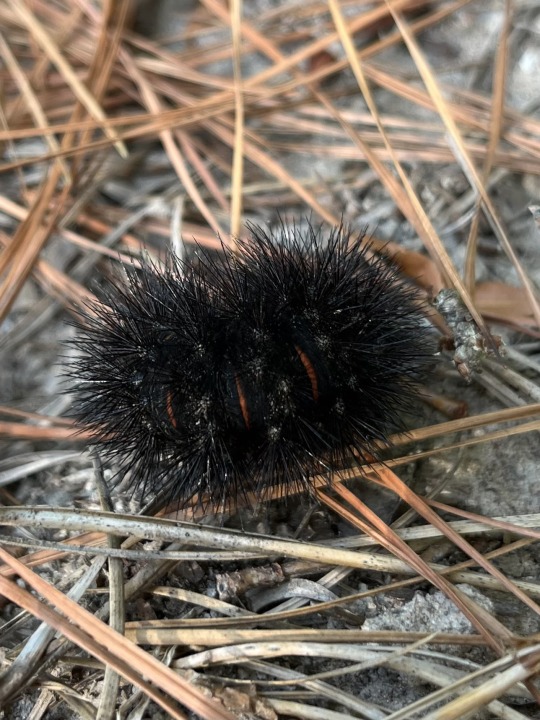
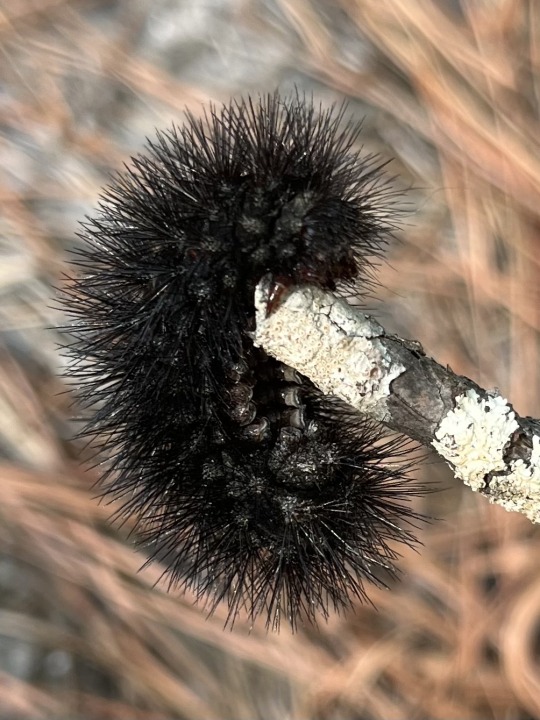
What caterpillar is this? Found in Houston, Texas.
why, it’s my dear friend scribby
122 notes
·
View notes
Text








The giant leopard moth (Hypercompe scribonia) is a moth of the family Erebidae. They are distributed through North America from southern Ontario, and southern and eastern United States through New England, Mexico, and south to Colombia.The obsolete name, Ecpantheria scribonia, is still occasionally encountered.
They are known to be attracted to bitter, unripe vegetables and broccoli flowers.
This moth species has a wingspan of 76 mm (3 in). Its wings are bright white with a pattern of neat black blotches, some solid and some hollow. The overside of the abdomen is dark blue with orange markings, while the underside is white with solid black spots, and males have a narrow yellow line on the sides. Their legs have black and white bands. Adult moths are strictly nocturnal and do not generally fly before nightfall.
This species has a notable sexual dimorphism in size, with the adult male reaching about 51 mm (2 in) in length, while the adult female grows up to 30 mm (1.2 in).The leopard moth requires two years to complete its round of life. In Missouri, adults are on the wing from May to September and are multivoltine. During mating sessions, the wings of the male cover most of the female's abdomen, which can sometimes lead to the loss of wing scales in the female and have negative effects on her flight efficiency. Their mating sessions are notably long-lasting, taking more than 24 hours. They stay mostly immobile during the whole process, but move from spot to spot to thermoregulate, walking into shadowy areas if too hot or into sunlight if too cold. The male effectuates the locomotion, while the female folds her legs to make her easier to carry.
The caterpillar is of the "woolly bear" kind, with a thick coat of black bristles (setae) and red or orange bands between its segments, which become conspicuous when the caterpillar rolls into a ball for defense. Like the banded woolly bear, its hairs are not urticant nor venomous and do not typically cause irritation. The moth overwinters as a caterpillar, often under the bark of decaying wood.The caterpillar grows to be 7.6 cm (3 in) long.
16 notes
·
View notes
Text


Giant leopard moth (Hypercompe scribonia) caterpillar predated by opossum, by sdrov on iNaturalist
5 notes
·
View notes
Text
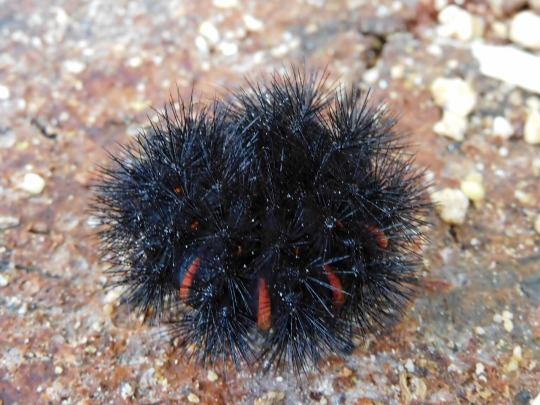
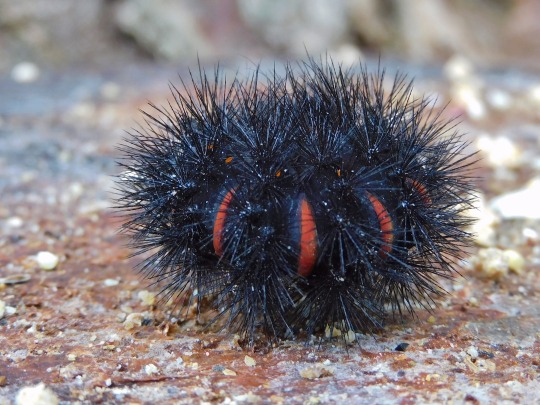
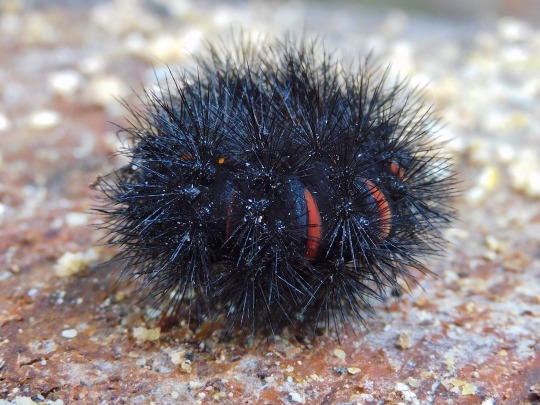
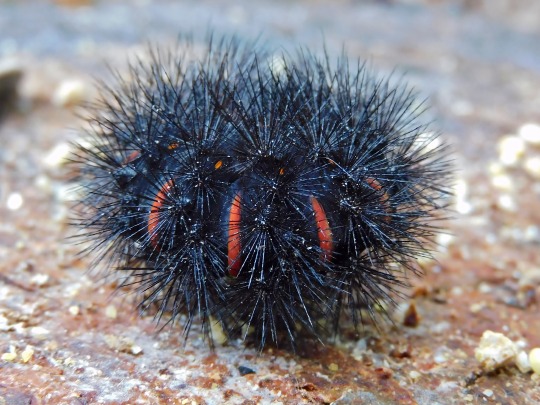
A Giant Leopard Moth (Hypercompe scribonia) caterpillar, all curled in a ball because I ejected it from one of the chicken nesting boxes...
#nature#my photography#insect larva#moth#leopard moth#backyard nature#moth caterpillar#nature photography#insects#wildlife photography
11 notes
·
View notes
Text
Another pattern listed on Ko-fi, this one is of a Giant Leopard Moth I saw the other day ::-]
Same as my other pattern for sale, this comes in 2 variations and they're yours for $2 !
5 notes
·
View notes
Note

Not sure what kind this little friend is!!! Found in the Northeast us (New England haha) back in July
Moth ID - NE US:
Hllo, yess, this is the Giant Leopard Moth (Hypercompe scribonia), family Erebidae.
Giant leopard moth - Wikipedia
168 notes
·
View notes
Text

Giant Leopard Moth (Hypercompe scribonia)
2 notes
·
View notes
Text
Back on my hyperfixation shenanigans so I have not slept and here's a list of what I consider to be the prettiest beetles, butterflies and moths, damselflies, and grasshoppers and crickets that inhabit Colorado and Kentucky according to insectidentification.org :
COLORADO
Emerald ash borer (Agrilus planipennis)
Fifteen-spotted lady beetle (Anatis labiculata)
Golden tortoise beetle (Charidotella sexpunctata)
Knapweed root weevil (Cyphocleonus achates)
Longhorn beetle (Semanotus amethystinus)
Dogbane Leaf Beetle (Chrysochus auratus)
European Ground Beetle (Carabus nemoralis)
Golden Net-wing Beetle (Dictyoptera aurora)?
Margined Blister Beetle (Epicauta funebris)
May Beetle - P. lanceolata (Phyllophaga lanceolata)
Mottled Tortoise Beetle (Deloyala guttata)
Pleasing Fungus Beetle (Gibbifer californicus)
Poplar Borer Beetle (Saperda calcarata)
Shining Leaf Chafer - Anomala spp. (Anomala spp.)
Signate Lady Beetle (Hyperaspis signata)
American Lappet Moth (Phyllodesma americana)
Cinnabar Moth (Tyria jacobaeae)
Common Checkered-Skipper (Pyrgus communis)
Glover's Silkmoth (Hyalophora columbia gloveri)
Great Ash Sphinx Moth (Sphinx chersis)
Autumn Meadowhawk (Sympetrum vicinum)
Black Saddlebags Skimmer (Tramea lacerata)
Bird Grasshopper (Schistocerca spp.)
Obscure Bird Grasshopper (Schistocerca obscura)
Sooty Longwing Katydid (Capnobotes fulginosus)
KENTUCKY
Andrew's Snail-eating Beetle (Scaphinotus andrewsii)
Black Firefly (Lucidota atra)
Calligrapha Beetle (Calligrapha spp)
Eastern Hercules Beetle (Dynastes tityus)
Emerald Euphoria Beetle (Euphoria fulgida)
Glowworm (Phengodes spp.)
Goldsmith Beetle (Cotalpa lanigera)
Metallic Wood-boring Beetle: Chalcophora (Chalcophora fortis)
Notched-mouth Ground Beetle (Dicaelus purpuratus)
One-spotted Tiger Beetle (Apterodela unipuncata)
Rainbow Darkling Beetle (Tarpela micans)
Rainbow Scarab Beetle (Phanaeus vindex)
Six-spotted Tiger Beetle (Cicindela sexguttata)
Southern Sculptured Pine Borer Beetle (Chalcophora georgiana)
Stag Beetle (Lucanus capreolus)
Twice-stabbed Lady Beetle (Chilocorus stigma)
Vietinghoff's Ground Beetle (Carabus vietinghoffii)
Abbott's Sphinx Moth (Sphecodina abbottii)
American Ermine Moth (Yponomeuta multipunctella)
Arched Hooktip (Drepana arcuata)
American Bird's-Wing Moth (Dypterygia rozmani)
Arcigera Flower Moth (Schinia arcigera)
Attentive Crocus Moth (Xanthotype attenuaria)
Basswood Leafroller (Pantographa limata)
Beautiful Wood-Nymph (Eudryas grata)
Black-waved Flannel Moth (Megalopyge crispata)
Blackberry Looper (Chlorochlamys chloroleucaria
Blinded Sphinx Moth (Paonias excaecata)
Bluish Spring Moth (Lomographa semiclarata
Buck Moth (Hemileuca maia)
Carmine Snout Moth (Peoria approximella)
Carrot Seed Moth (Sitochroa palealis)
Cecropia Silk Moth (Hyalophora cecropia)
Changeable Grass-Veneer (Fissicrambus mutabilis)
Colorful Zale (Zale minerea)
Common Lytrosis Moth (Lytrosis unitaria)
Confused Eusarca (Eusarca confusaria)
Cross-lined Wave (Timandra amaturaria)
Curve-toothed Geometer (Eutrapela clemataria)
Dark-banded Geometer (Ecliptopera atricolorata)
Deep Yellow Euchlaena (Euchlaena amoenaria)
Diaphania costata (Diaphania costata
Dimorphic Macalla (Epipaschia superatalis)
Dot-lined White (Artace cribrarius)
Dotted Gray (Glena cribrataria)
Drab Prominent (Misogada unicolor)
Eight-spotted Forester Moth (Alypia octomaculata)
Elder Shoot Borer (Achatodes zeae)
Explicit Arches (Lacinipolia explicata)
Eyed Paectes Moth (Paectes oculatrix)
Falcate Orangetip (Anthocharis midea) (female)
Fall Webworm (Hyphantria cunea)
False Crocus Geometer (Xanthotype urticaria
Fervid Plagodis (Plagodis fervidaria)
Fig Sphinx (Pachylia ficus)
Friendly Probole Moth (Probole amicaria)
Giant Leopard Moth (Hypercompe scribonia)
Goldcap Moss-eater Moth (Epimartyria auricrinella)
Gray-edged Hypena (Hypena madefactalis)
Green Arches (Anaplectoides prasina)
Hag Moth (Phobetron pithecium
Hibiscus Leaf Caterpillar Moth (Rusicada privata)
Imperial Moth (Eacles imperialis)
Lesser Maple Spanworm Moth (Speranza pustularia
Luna Moth (Actias luna)
Melissa Blue Butterfly (Plebejus melissa spp.)
Modest Sphinx Moth (Pachysphinx modesta)
Morbid Owlet Moth (Chytolita morbidalis)
Orange-patched Smoky Moth (Pyromorpha dimidiata)
Pale Beauty (Campaea perlata)
Pale Lichen Moth (Crambidia pallida)
Pale Metarranthis (Metarranthis indeclinata)
Pandorus Sphinx Moth (Eumorpha pandorus)
Parthenice Tiger Moth (Apantesis parthenice)
Pearly Wood-Nymph Moth (Eudryas unio)
Pero Moth (Pero spp.)
Pink-patched Looper (Eosphoropteryx thyatyroides)
Pipevine Swallowtail (Battus philenor)
Pistachio Emerald Moth (Hethemia pistasciaria)
Plebeian Sphinx Moth (Paratrea plebeja) (Caterpillar)
Primrose Moth (Schinia florida)
Promiscuous Angle Moth (Macaria promiscuata)
Raspberry Pyrausta��(Pyrausta signatalis)
Rustic Sphinx Moth (Manduca rustica)
Saddleback Caterpillar Moth (Acharia stimulea)
Saddled Yellowhorn (Colocasia flavicornis)
Salt-and-pepper Looper Moth (Syngrapha rectangula)
Satin Moth (Leucoma salicis)
Scarlet-winged Lichen Moth (Hypoprepia miniata)
Schlaeger's Fruitworm Moth (Antaeotricha schlaegeri)
Showy Emerald Moth (Dichorda iridaria)
Small Bird Dropping Moth (Ponometia erastrioides)
Snowy Urola (Urola nivalis)
Sorghum Webworm Moth (Nola cereella)
Southern Flannel Moth (Megalopyge opercularis)
Southern Longhorn Moth (Adela caeruleella)
Southern Pine Sphinx (Lapara coniferarum)
Southern Tussock Moth (Dasychira meridionalis)
The Badwing (Dyspteris abortivaria)
Unspotted Looper Moth (Allagrapha aerea)
Venerable Dart Moth (Agrotis venerabilis
Vine Sphinx Moth (Eumorpha vitis)
Walnut Sphinx Moth (Amorpha juglandis)
Wavy-lined Emerald Moth (Synchlora aerata)
Western Grapeleaf Skeletonizer Moth (Harrisina metallica)
White Flannel Moth (Norape ovina)
White Slant-line Moth (Tetracis cachexiata)
White-fringed Emerald Moth (Nemoria mimosaria)
Yucca Moth (Tegeticula, Greya, and Prodoxus spp.)
Carolina Locust (Dissosteira carolina)
Eastern Shieldback Katydid (Atlanticus spp.)
Slender Meadow Katydid (Conocephalus fasciatus)
True Katydid (Pterophylla camellifolia)
Ebony Jewelwing (Calopteryx maculata)
Midland Clubtail (Gomphurus fraternus)
Red Saddlebags (Tramea onusta)
Seepage Dancer (Argia bipunctulata)
5 notes
·
View notes